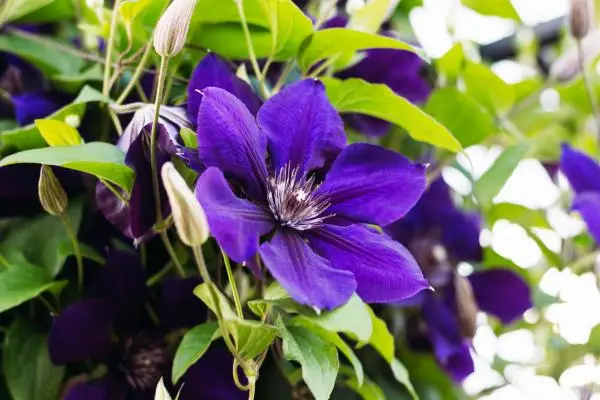The clematis or clematis is actually a whole genus of climbing plants in the Ranunculaceae family, which has more than 400 cultivars under its belt. The so-called joys of the travelers or flower of the dreamers are plants of great beauty and resistance that develop in the wild without difficulties and especially in humid climates, such as the English countryside, from which some come.
If you want to learn more about the care of the clematis or clematis plant, join us in this article.
Clematis plant characteristics
Clematis are herbaceous plants and woody plants, as well as being climbing plants, with leaves that are divided into three leaflets and shades of green that lighten or darken depending on how much sun they receive. There are perennial and deciduous ones, although what stands out the most is the clematis flower, which appears in the warm months and is easily distinguished by its showy tepals, which almost look like petals. This flower is also very aromatic, with an intense perfume reminiscent of jasmine, and is highly appreciated by botanical and gardening enthusiasts. Trellised or with a suitable surface to climb on, clematis can reach heights of up to 5 meters, making them a great option for decorating walls, trees, or pergolas.
However, special attention must be paid to growing them in areas where there are pets or small children, as these plants are toxic: their essential oils and compounds are irritating to the skin and mucous membranes and can cause more serious damage if ingested. in great quantities; something that really is not easy to happen.
Despite this, in small enough quantities the plant can have positive effects. It is a proven bactericide and was traditionally used by American Indians to relieve the symptoms of migraines and nervous disorders.
Location for clematis
These plants should preferably be located outdoors given their climbing nature. If you like this type of plant, here you can discover many more Climbing plants.
It is possible to plant clematis both in a pot and in the ground directly:
- In a pot, it is vital to place a good tutor or cane , in addition to using a container of sufficient size and drainage holes. In this sense , ceramic pots work better , since the material has a better ability to release excessive moisture as it is porous.
- In the garden, it will be necessary to locate the plant near where we want it to climb, be it a lattice or another structure. Prepare a hole of about 50 x 50 cm, next to the platform that you want it to climb, and place it next to a guide or tutor that leads the clematis to this structure where it will grow. It is advisable to dedicate a tree to a certain depth, which helps the plant to gather more moisture around its soil.
Regarding its light needs, clematis can be grown both in full sun and in semi-shade. In fact, the common thing is that its leaves and stems grow to look for the morning light, which will come in handy, while the roots appreciate an area of semi-shade to maintain a little more humidity. Direct sun in the central hours of the day, especially in hot climates or like the Mediterranean, can be excessive for this plant.

Irrigation of clematis
One of the most important points in clematis care is watering. It is a plant that needs high levels of humidity and, in addition, does not tolerate drought. A young clematis will need frequent waterings, although a strong adult can survive very specific periods of up to ten days without water.
Under normal conditions, it will need to be watered between one and three times a week, depending on the ambient humidity and the characteristics of the soil. Of course, it is especially important not to flood when watering, since clematis, although it needs abundant humidity, does not tolerate flooding.
Soil or substrate for clematis
This is another of the key points of its care: a soil or substrate with great drainage is necessary, to avoid such harmful flooding, as well as being very rich in organic matter, something vital for it to flourish in spring or summer.
Adding worm humus to the soil or substrate is an especially recommended option, as is using a very light coconut fiber or peat base. Vermiculite and perlite, as we always say, are recommended.
Climate for clematis
Depending on the variety and the age of the plant, its resistance to frost is different. During their first year, most varieties do not tolerate them, while afterward, some can endure temperatures of up to -10 ºC from time to time, but this does not apply to all of them. Find out about the weather needs of your specific clematis species. In the same way, almost none tolerates direct sun in hot areas and at the hours of greatest incidence of the sun, when it is much stronger.

Compost for clematis
During all warm months, you should add compost to your clematis. The ideal is to do it with organic fertilizer, which is always a more ecological option, such as hummus, compost, or guano.
